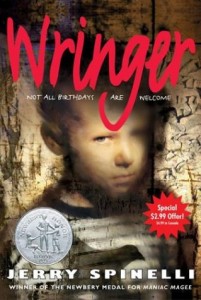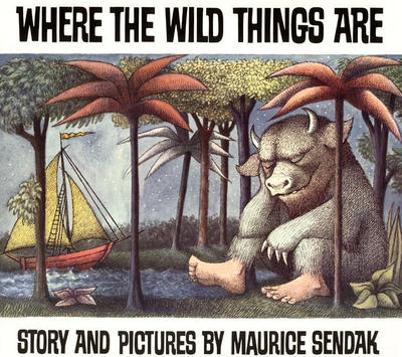Wringer
 The first book I remember reading cover to cover (without being required to), was Wringer by Jerry Spinelli, published by HarperCollins in 1997. It tells the story of ten year old Palmer LaRue, who is faced with a moral dilemma. In Palmer’s hometown, it is a tradition for all the boys who have turned ten to wring the necks of injured pigeons on Pigeon Day. Thousands of pigeons are released and shot as a way to raise money for the city park. This is considered an honor and a rite of passage for the boys. Everyone around seems to be looking forward to it, except Palmer. The idea of it tortures him; he is taunted by the thought. He even ends up taking in a pet pigeon, who he names Nippy. The only person who knows about his new pet is Dorothy, his best friend, who is also against the festivities on Pigeon Day.
The first book I remember reading cover to cover (without being required to), was Wringer by Jerry Spinelli, published by HarperCollins in 1997. It tells the story of ten year old Palmer LaRue, who is faced with a moral dilemma. In Palmer’s hometown, it is a tradition for all the boys who have turned ten to wring the necks of injured pigeons on Pigeon Day. Thousands of pigeons are released and shot as a way to raise money for the city park. This is considered an honor and a rite of passage for the boys. Everyone around seems to be looking forward to it, except Palmer. The idea of it tortures him; he is taunted by the thought. He even ends up taking in a pet pigeon, who he names Nippy. The only person who knows about his new pet is Dorothy, his best friend, who is also against the festivities on Pigeon Day.
Palmer fakes enthusiasm to fit in with his guy friends so that he is considered “cool”. On Pigeon Day, Palmer finds out that Dorothy accidently let Nippy out of his cage near the area where pigeons are captured for the festival. Palmer rescues an injured Nippy from the shooting zone in front of the entire town. The story ends with a little boy, while watching Palmer, tell his father he wants a pet pigeon.
We have talked a lot in class about the gender roles in children’s toys and books. This book is the exact opposite of the gender focused books described by Elizabeth Segel. Palmer is not very adventurous and he relates more to his best friend Dorothy than the popular boys in his class, Mutto, Henry and Beans. There is definitely male focused comedy associated with these three boys, (bathroom jokes, etc). The combination of the soft thoughts of Palmer and the rowdy boys in his class allows for this book to be appreciated by both boys and girls.
I never understood until recently why this book meant so much to me. At the point when I was reading this I was eight years old, so I did not think much about it. Looking back today I realize it is because the story is about a boy who does not fit into his society’s idea of what a boy should be or act. I was a girl faking it with my friends and family, though I did not know why. Now I know why I felt so different, I am gay. Palmer’s story of fighting for how you feel inside, even though everyone around you may reject you, is something that sticks with me to this day. This book bends the gender roles we have established for our children. It says: be who you want to be, no matter what the world is telling you.





